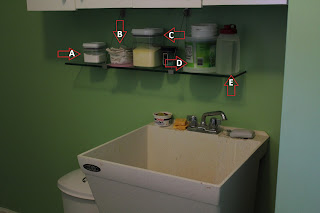Flat out replacing them would be cheap but booooooring and buying fancy ones is expensive (relatively speaking: $6.54 is 18 times more than $0.35!), so I went off the internet in search of ideas.
Ugh! If you look closely at the bottom outlet, you can see some paint on it. I told you the previous owners did a really bad paint job. And the reason the wall isn't painted yet in the after picture is because they were also really bad at patching holes in the wall. We've spent a few hours sanding them...
Start off by removing all the covers from the wall.
Then was all the dirt off and leave them to dry for a few minutes. (notice the old toothbrush I wound up needing for the tight corners)
While they were drying, I assembled everything else I'd need for the job: scrapbook paper, pencil, scissors, Mod Podge, sponge brush, a knife, and some heavy books. And a piece of plywood that came with our elliptical that I use for a work surface.
As it turns out, a piece of scrapbook paper is 12x12 in. and you need about 4x6 in. to cover each plate. That means you can cover 6 of them with one piece of paper. Financially speaking, we could either spend $32.70 on those fancy rubbed bronze ones from Lowe's or we could spend $0.30 on some scrapbook paper (it was 50% off at Hobby Lobby!). And if we had to buy new covers*, that still would have only been $2.05. Not bad at all! :)
*And even if you also had to buy a pencil, scissors, Mod Podge, a brush, and a knife, you would've spent less than $32.70.
Cut the paper and brush the cover with a light layer of Mod Podge. Be sure not to leave it too thick in some areas! If you do, the paper will bunch like it did with my "after" example.
Place the cover upside down on the paper and hold it for a few seconds to smooth out the wrinkles.
Now make diagonal cuts from the corner of the paper towards the cover. I also went ahead and trimmed the corners so there would be less bulk.
Now glue the back of one section of the paper and press it against the side. Then, once it's securely glued, fold it over and press it again.
Repeat for the other 3 sections.
This is where things like Elementary Differential Equations and Advanced Engineering Mathematics really come in handy! Place the covers paper-side down and put the books on them. There are three under the first book and two under the second. Let them dry for 20-30 minutes.
Once they're dry, flip them over and make 4 diagonal cuts (or 8 radial cuts) in each outlet hole and 2 diagonal (4 radial) in the light switch hole. Apply Mod Podge to the paper and fold it back.
Now carefully brush a light layer of Mod Podge over the paper and let it dry. I did a second layer just because.
Finally, hold the cover up to the light to poke the screws where they belong. Then screw them into the walls and enjoy!


























































